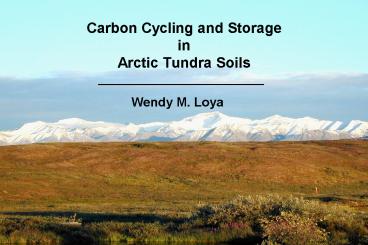Carbon Cycling and Storage in Arctic Tundra Soils - PowerPoint PPT Presentation
1 / 38
Title:
Carbon Cycling and Storage in Arctic Tundra Soils
Description:
National Science Foundation Office of Polar Programs. Sigma Xi Grants-in ... Kama Thieler Bryan Stork. Marty Downs Angela Chapes. Annika Nordin Denise Walker ... – PowerPoint PPT presentation
Number of Views:132
Avg rating:3.0/5.0
Title: Carbon Cycling and Storage in Arctic Tundra Soils
1
Carbon Cycling and Storagein Arctic Tundra Soils
Wendy M. Loya
2
Acknowledgements
- Committee
- Loretta Johnson
- John Blair
- Charles Rice
- Knute Nadelhoffer
- John Leslie
- Collaborators
- George Kling
- Jennifer King
- William Reeburgh
- Gaius Shaver
- Funding
- National Science Foundation Office of Polar
Programs - Sigma Xi Grants-in-Aid of Research Award
- Division of Biology, Kansas State University
Harvest , laboratory data help Jesse
Nippert Sarah Allen Kama Thieler Bryan
Stork Marty Downs Angela Chapes Annika
Nordin Denise Walker Vicki Charbonneau James
Clark Sarah Behrens Sarah Glaser Tate
Gooden Mendy Smith Roxanne Fagan Jason
Russell Additional Invaluable support Richard,
Beth Dakota Loya Tate, Sister, Kodiak Fellow
grad students Faculty Staff of Division of
Biology Ecosystems Center Researchers Staff,
Woods Hole
3
Were not in Kansas anymore.
Arctic Tundra LTER Toolik Lake, Alaska 68 38'N,
149 43'W elevation 760 m
4
Global Climate Change in the Arctic
SURFACE AIR WARMING (F) 2 X CO2
Source GFDL R15 Climate Model CO2 transient
experiments, years 401-500.
5
Distribution of Arctic Tundra Ecosystems
6
Carbon Storage in Tundra Soils
7
Distribution of C in Tundra Soils
A S
WS
NPE
A I S
8
Tundra Carbon Cycle Inputs, Transformations,
Pathways
9
Objectives
- To trace C movement from leaf litter, root
litter, and root-derived materials into soil
organic matter (SOM). - Comparison of root-derived C inputs in two tundra
types - Tracing the fate of C from leaf and root litter
as it enters SOM fractions - The effects of nutrient availability on
- C cycling and storage
10
Why use 14C ? 12C, 13C, 14C
RADIOACTIVE
- Low background levels in plants and soils makes
tracing easy - Easy and rapid detection in samples via
scintillation counting
- We used 14C in order to determine.
- Quantity of C allocated to soils and proportion
of C inputs retained - Pathways through which C moves into SOM fractions
- Rate at which C moves into SOM
11
1. 14C Pulse-labeling of Tussock Tundra and Wet
Sedge Tundra
12
14C Pulse-labeling of Tundra Mesocosms
13
Recovery of 14C One Day after Uptake
Additional data from Nadelhoffer, Kling, King
of Total 14C Activity Recovered
Ecosystem Component
14
14C in Bulk Soils and Microbial Biomass
Tussock Tundra
Wet Sedge Tundra
15
14C Movement among SOM Fractions
of Total Soil 14C Activity
Time (days)
16
14C Movement among SOM Fractions
of Total Soil 14C Activity
Time (days)
17
Root-derived C Dynamics in Tundra Soils
- Tussock Tundra
- Direct microbial uptake
- Losses to respiration
- Incorporation into SOM
- Wet Sedge Tundra
- Inputs to SOM
- Indirect microbial uptake
- Losses to respiration
18
- Contribution of Leaf and Root Litter to C Storage
and Cycling in Tussock Tundra
- Objectives
- To trace the fate of C from leaf root litter
over the course of a simulated year - To determine the effects of plants on
decomposition processes
19
14C Labeled Leaf and Root Litter Decomposition
20
Initial Litter Quality and Distribution of 14C
NPE Non-Polar Extractives (lipids) WS Hot
Water-Soluble (carbohydrates, phenols) AS Acid
Soluble (cellulose, hemicellulose) AIS
Acid-Insoluble (lignin) Proximate Carbon fraction
methods as outlined in Ryan et al., 1990
21
Contributions of 14C from Litter to SOM
LEAF LITTER
ROOT LITTER
of Initial 14C Activity Remaining
Harvest Period
22
Movement of 14C into SOM fractions Lipids
Root Litter
Leaf Litter
N P E
of Total Initial 14C Activity
Harvest Period
23
Movement of 14C into SOM fractions Labile C
Leaf Litter
Root Litter
W S
of Total Initial 14C Activity
Harvest Period
24
Movement of 14C into SOM fractions Intermediate C
Leaf Litter
Root Litter
of Total Initial 14C Activity
Harvest Period
25
Movement of 14C into SOM fractions Recalcitrant
C
Root Litter
Leaf Litter
of Total Initial 14C Activity
Harvest Period
26
Summary
- Leaf litter decomposes more rapidly in the
presence of plants, likely due to favorable soil
moisture and temperatures. - The presence of living plants reduces the rate of
root litter C losses. - Labile C from both types of litter was rapidly
depleted, but was later replenished from more
recalcitrant pools. - Recalcitrant C is depleted under freeze-thaw
conditions in all treatments. - A year after additions of litter, the majority of
the C remaining is in intermediate recalcitrant
forms.
27
Tundra Carbon Cycle Inputs, Transformations,
Pathways
28
3. How increased nutrient availability alters C
cycling and storage
Control (unfertilized)
Fertilized (N P)
29
14C Pulse-labeling of Wet Sedge Mesocosms
30
Soil Properties
31
Bulk Soil 14C Activity
32
Soil 14C Activity in Relation to Plant Biomass
Estimates
33
Distribution of 14C among SOM fractions
of Bulk Soil 14C
34
Microbial Biomass C and 14C
35
Summary
- Recovery of 14C was 60 greater in fertilized
soils - Attributed to greater aboveground biomass rather
than root biomass - Microbial assimilation of root-derived C appears
to be more rapid in fertilized soils - Greater microbial biomass
- Lower soil moisture
- Control mesocosms contain slightly more AIS C
which may indicate differences in quality of
root-derived C
36
ConclusionsC Cycling Storage in Tussock Tundra
37
ConclusionsC Cycling Storage in Wet Sedge
Tundra
38
(No Transcript)































